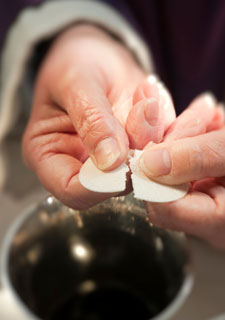 O God, whose blessed Son made himself known to his disciples in the breaking of bread: Open the eyes of our faith, that we may behold him in all his redeeming work; who lives and reigns with you, in the unity of the Holy Spirit, one God, now and for ever. Amen. This prayer comes up every year on the third Sunday of Easter – not the third Sunday after Easter, but of Easter, because Easter, as Fr. Gene reminded us last week, is 50 days long. Easter has 7 Sundays in it, and this is the third, and every year the church asks us to pray these words: Open the eyes of our faith, that we may behold him in all his redeeming work. We see over and over in the resurrection appearances in the Gospels how difficult it was for the disciples to grasp what was right in front of them, Jesus Christ in his resurrected body. They needed their eyes opened. Remember, Mary Magdalene didn’t even recognize Jesus at first; she thought he was the cemetery gardener. Last week, Thomas simply told the other disciples he didn’t believe them when they said they had met the risen Christ. Just doesn’t happen. No way. And today, the writer Luke piles up adjectives to convey how tough it was for them to see what was right in front of them: “startled, terrified, frightened, disbelieving, wondering.” Open the eyes of our faith, that we may behold him in all his redeeming work. Without the eyes of our faith opened by the direct action of God, what we will behold is Jesus in part of his redeeming work. We’ll see the part we’re inclined to want to see, or the part we already approve of. We can only go so far in understanding God without God’s help, or as a friend of mine says, it takes God to know God. The assumptions we carry and the blinders we wear as we come to the Bible affect how much of what’s there we are able to behold. This may be especially so when the topic is the Risen Christ and what his resurrection means and does.
0 Comments
I have a wrist watch that is 68+ years old. It is a winder—unless I wind it it stops. There is no battery to be replaced. The watch keeps excellent, dependable time if I wind it. It was manufactured in Illinois but was a graduation gift to me from my parents when I was graduated from high school in Mansfield Louisiana. It is an Elgin. The Elgin clockworks has long since ceased operation and my wrist watch is now a sought-after collectors item. Did I have any idea that it would be “collected,” when I first saw it in Stott's Jewelry Store in my home town in Louisiana? Not at all. Its value to me is mostly sentimental. It represents the love and pride my parents expressed for my achievement in graduating from Mansfield High School.
As a timepiece, the value of my Elgin wrist watch depends upon my taking care of it and winding it daily. Then it keeps time accurately if I wind it. In the liturgical year the time is the second Sunday of Easter. Easter lasts for fifty days until Pentecost. After the celebration of Easter Sunday and the various disciplines we followed during Lent, we may feel that it's time to coast until the excitement of Pentecost. (Dig out your red clothing to be ready!) What do our Lessons tell us of the challenges of this Season?  If you were writing up an inspiring story of renewed hope, is that how you would do it? We just read the apostle John’s narrative of what happened Easter morning, and it was rather long and involved, and not until the very end did we hear anything inspiring and hopeful. For most of the reading, what we heard was confusion, running around, and slightly odd minor details. Some of those details seem less odd if you know how Jewish burials of that time worked. Bodies were not interred in the ground; instead, there was a two-step process. First the family took the body of their loved one to a large grave chamber with special shelves carved into it, and left it there on one of the shelves, wrapped with aromatic spices in a cloth. About a year later, the next of kin came back to that shelf, after decomposition was complete, and reverently gathered up the bones to put in a small box called an ossuary. You may have seen ossuaries in art museums. When the disciples John tells us about today arrive at the tomb where Jesus’ corpse had been laid, the shelf where it had been is vacant. The body is gone. John tells us that, which would seem to be a main point, but he also adds so many perplexing details. |
Archives
July 2024
Categories |

 RSS Feed
RSS Feed